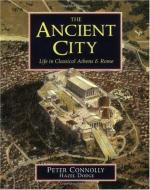
|
| Name: _________________________ | Period: ___________________ |
This test consists of 5 multiple choice questions, 5 short answer questions, and 10 short essay questions.
Multiple Choice Questions
1. This is a regular feature of Roman religion.
(a) Animal sacrifice.
(b) Prayer.
(c) Suffering.
(d) Donations.
2. Each household has one of these, dedicated to a specific God.
(a) Room.
(b) Cross.
(c) Shrine.
(d) Outbuilding.
3. The stage of the Theater of Marcellus is _________.
(a) Simple.
(b) Complex.
(c) Missing.
(d) Uniform.
4. This invention helps make way for the building of the Colosseum, the Baths of Trajan and the Temple of Venus.
(a) Cranes.
(b) Mortar.
(c) Brick.
(d) Concrete.
5. It is under these emperors that Rome comes into its Golden Age.
(a) Augustus and Maximus.
(b) Trajan and Hadrian.
(c) Augustus and Caligula.
(d) Nero and Celete.
Short Answer Questions
1. By the first century BC, theater is geared toward this.
2. The Theater of Marcellus is dedicated in this time.
3. Rome's position on the this river provides it with a great defensive posture.
4. The Hellenised Egyptian goddess ____ also has a cult in Rome.
5. Living conditions in Rome are so dirty this ruler passes a decree ordering home owners to clean the areas in front of their homes.
Short Essay Questions
1. Explain the imperial cult, in as much detail as possible.
2. What are two of the factors that help Rome develop further and faster than other cities?
3. Explain the development of the equestrian order in the third and second centuries.
4. Describe the summer dining rooms in wealthy houses.
5. Describe the theater of Pompey.
6. Describe the great fire, Nero's response, and his scapegoat.
7. Describe the education of children in Rome. Be sure to include information about class differences, gender differences, and how the educational system was organized.
8. Explain the development of the aqueducts in Rome.
9. What is the Circus Maximus, where is it, and what is it made from?
10. Describe men and women's clothing and fashion in Rome. Be sure to include information about not only clothing, but also hairstyles, cosmetics, and any other information.
|
This section contains 955 words (approx. 4 pages at 300 words per page) |

|




